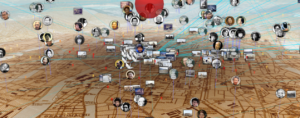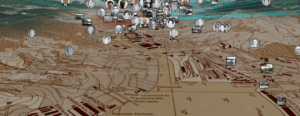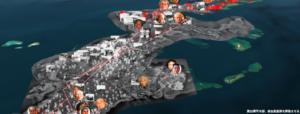Archives and activism: Ayenu ’17 at the Peace Resource Center in Wilmington, Ohio
Sep 12, 2017My co-op is at the Peace Resource Center in Wilmington, Ohio. The Center is a part of Wilmington College, a bigger-than-Antioch-but-relatively-small Quaker college. The Peace Resource Center was founded in 1975 by Barbara Reynolds, an anti-nuclear peace activist. She was married to an Antioch professor, Earle Reynolds. In the 1950s, he went to Hiroshima to study the nuclear bomb’s effects on the growth and development of children. The Reynolds family built a ship, The Phoenix of Hiroshima, and circumnavigated the world between 1954 and 1958. During this period they became peace activists, culminating their voyage by illegally sailing into a United States nuclear test zone. Barbara spent the rest of her life involved in nuclear disarmament and peace activism.
Along with the Barbara Reynolds papers, the Peace Resource Center houses the Hiroshima Nagasaki Memorial Collection. The archive holds materials related to Hiroshima / Nagasaki – highlighting the stories of survivors, and the Peace Movement in Japan. I had little experience with this history before I started this co-op and have gained a lot of knowledge since.
I am living in Yellow Springs. Wilmington is about a 45 minute drive from here. On a typical day, my supervisor Tanya picks me up at 8:30 and we listen to an audiobook and drive to Wilmington. We open the Peace Resource Center and I work on a project. At the beginning of the week, Tanya and I discuss projects I am working on and new ones that I could start. I have done a lot of hands-on organizational work with the archival materials, preparing them for processing. The archives are currently being reorganized and processed adhering to best practices.
Some of projects so far have been:
- Developing a process for accessioning new materials into the collection and writing a guide for future PRC employees
- Accessioning materials using PastPerfect collections management software
- Revising and editing the Center’s new Collections Management Policy
- Creating a workflow for digitization of audio cassettes
- Selecting primary source materials from the archive and doing research for a digital mapping exhibit
One of my favorite parts of co-op was during the second week. Two PhD students from Tokyo, Kenya Tamura and Hiroki Inoue came to Wilmington for a digital mapping workshop. They developed a program where you can create an archive of pictures, videos, or documents, and pin them on a map. The Peace Resource Center has received a grant to create exhibits using this software. Examples of exhibits created using their software can be accessed by clicking on the images below.
There were a few things that I loved about the workshop, mostly having to do with the process and the possibilities of digital mapping. I learned all about the field of “spatial humanities” that I previously didn’t even know existed. I think it is so exciting.
When the graduate students were presenting about how they use their program for education, they talked about how when they were schoolchildren in Hiroshima an atomic bomb survivor would come into the classroom and talk to the class, or a teacher would talk to the class – and how all of this created a hierarchy or a separation between the teacher and the student. They talked about how they created a collection with high school students in Hiroshima. They showed the students how to use the software and then the students conducted interviews with survivors. The students and survivors would map the pins together. I just thought it was so nice that it was collaborative and outside of a hierarchical structure, and that it blurs the roles that we expect to have in education. I was excited by this and started to think about how archives in general (whether they are mapped digitally or not) can function as this horizontal and empowering learning resource.
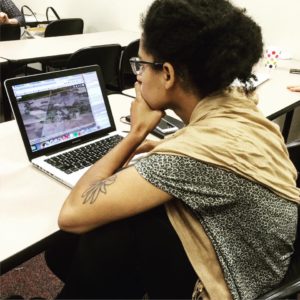
Here is a photo of me learning how to use the software
I am continuing to think about all this as I research and create content for the PRC’s digital exhibits. I am working on one for the Hiroshima Peace Pilgrimage – a 1964 pilgrimage where Barbara Reynolds took two atomic bomb survivors around the world to tell their stories, speak out against the use of nuclear weapons and demand an end to nuclear testing. I am also creating an exhibit for the Voyage of the Phoenix – the Reynolds family’s first trip around the world in their yacht. These exhibits will be used as teaching tools in Ohio high schools. I have been thinking about the state’s education curriculum and standards and considering how a project like this might fit. It has been challenging but fun.
This co-op has related to many of my professional goals. I plan to go to get a Masters of Library and Information Science and become a librarian. I enjoy working in archives and the skills are very related to librarianship. In my previous archive job, I worked under an archivist. She was really incredible and taught me so much. I worked with her for a year. At the Peace Resource Center, I have shifted positions. I am no longer working under an archivist and I have more knowledge and experience with archives than my supervisor. In the first week I had to push myself to speak up about more efficient and effective ways to do archival processes. I had to believe in my archival knowledge and be confident enough to name what wasn’t working.
Part of this job has been applying the skills I learned in my previous job, but without someone to tell me whether or not I was doing it right. This has taken some adjusting and I have had to grow more confident in my knowledge and skills. I’ve had to take more initiative researching archival questions I’ve had. In some ways, I have learned more about archival work in this position because I have had to face the things I didn’t know how to do, research them, and figure out how to do them on my own.
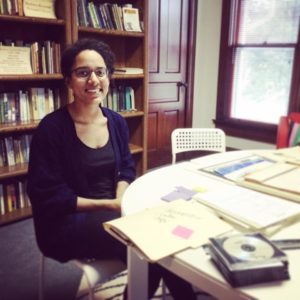
Inspiring Children through Art, Music, and Performance: Ciana Ayenu ’17 at CASA in San Francisco, California
Feb 09, 2016CASA (Children’s After School Arts) is an after school art program in San Francisco for children in kindergarten through fifth grade. The students who attend CASA go to an alternative public elementary school called Rooftop, where the program is held. CASA helps children reach their full creative potential through art, music, and performance. The program is extremely effective in helping children maximize their self-esteem and self-expression.
Learn more about CASA here!
My official title at CASA is “Teacher’s Aide,” but I do much more than what that entails. I arrived at Rooftop School to work at CASA on April 7th. I took a bus and walked up a big hill, where I had a beautiful view of San Francisco. The school is located in the Twin Peaks neighborhood, which has the most expansive view of the city.
During the school day, I was working mostly with the kindergarteners. My duties included assisting the teachers with whatever they needed (setting up lessons, keeping the kids under control, cleaning, comforting upset children). Consistent tasks included monitoring play time on the playground, passing out pillows and blankets to students during silent rest time and rubbing their backs to comfort them, reading books for story time, passing out snacks, and sweeping the floor at the end of the day. Aside from these things, work was different everyday. Sometimes, kids would get in fights on the playground and they’d ask me to step in to help them come to a resolution, there were occasionally injuries or crying kids to deal with. I learned a lot about conflict resolution. Through the unpredictable events of a school day, I figured out how to respond quickly and effectively to a variety of situations.
In addition to these things, I helped out a lot with the CASA play and taught an art lesson, a goal I set for myself in the beginning of my co-op. I spent a long time thinking about something that would be at a kindergarten level (a surprisingly difficult task) and also unique and fun – something that would allow the students produce interesting pieces of art.
I decided to teach about the Dutch painter, Piet Mondrian. I was pretty nervous because I had never taught an art lesson before, but once I started, my nerves went away. I began by telling the students about Mondrian and showing them pictures of his work. I asked them what they noticed about it and we had a pretty in depth conversation about their observations. I told them that they’d be making pieces inspiredby his work and I handed out white sheets of paper, long black strips of paper, scissors, glue, and red, yellow, and blue paint. The students made a design on their paper with the black paper and then painted in the sections they created. The results were pretty amazing!
Some students even came up to me after the lesson to tell me how much they loved it. During free play at the end of the day, when students decide which activities they want to do (usually playing with blocks and legos or drawing) a few wanted to make more Mondrian inspired paintings. Seeing the kids so excited about my lesson made me feel wonderful. Knowing that I piqued their interest in something was amazing and seeing their work was rewarding. This experience definitely increased my interest in teaching (which I previously thought was a non-existant interest).
Family Soup
Every school year, CASA has a theme. This year’s theme was “Family.” At the end of the year, the program puts on a play. This year’s play was called Family Soup. The main roles are filled by fifth graders, and every other grade plays a part – usually a song and/or a dance. The kindergarteners sang a song to open the show. I sang it with them everyday to help them prepare. I spent long hours on weekends making and organizing props. I also went to all the rehearsals and helped out with whatever was needed.
The play was written by Leslie Einhorn, the director of CASA (an alumnae of Antioch) with help from students. There was a live band and two shows were put on with full crowds in a large high school theater. The play is about a futuristic American dictator named Hammerhead, who declares that every family needs to be “perfect.” Because CASA focuses so much on social justice issues, the play explores all types of families and discusses racism and homophobia, among other things.
During the play, I was in charge of all the third graders. I gave them their cues and passed out their props, and made sure they behaved in the audience. Putting on Family Soup was a lot of hard work, but an equal amount of fun. The end result was an amazing production!
School ended on May 30th and now I am working at CASA summer camp. It is a much different environment. There are less students, and they are in a mixed age group (kindergarten through sixth grade). At summer camp, I am mostly there to make sure the kids are safe. We go on long walks every day and I make sure that the students stay in the group. Twice a week, we go on field trips where we ride the city bus and do a lot of walking. Last week we went to the Conservatory of Flowers, and this week we went to the Botanical Garden.
When we’re not on field trips, I play with the kids and make sure they’re having fun, I supervise them on the playground to make sure they are staying safe, and I help them with art projects.
Summer camp is a nice way to end my co-op. I’m able to have more one-on-one time with students, which I’ve found is really important for expanding their knowledge and self-esteem. It’s rewarding for them and myself.




